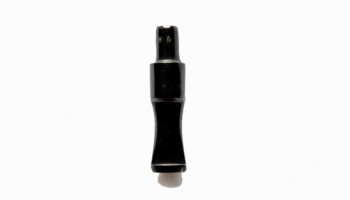- There are no more items in your cart
- Shipping Free
- Total €0.00

The different types of pipe mouthpieces
Published : 11/14/2021 17:43:06 - Categories : Pipe
Since the pipe has existed, there are many materials that have been used to make the mouthpieces.
Let's find out the main ones with their characteristics, strengths and weaknesses.
EBONITE is undoubtedly still today the most popular material on pipes. This material (composed of rubber or caoutchouc hardened in a sulfur bath). The advantage of this material is to be able to obtain mouthpieces by molding and the mouthpiece (or tooth) can be made thinner to avoid excess salivation. This material is quite comfortable under the teeth but you have to be careful not to get too familiar with it because being soft it is easy to scratch it with your teeth. The flaw of this material is the change in color to which the material is subjected with the passage of time. Light is the enemy of ebonite; it makes the sulfur part emerge, making the mouthpiece greenish or even yellow (risking pinching on the tongue during smoking). No problem, a nice grind and it turns black as it just came out of the factory.
HORN, also improperly called bone, taken from the horns of animals (generally buffaloes), was widely used around the 1940s-1960s. Many smokers still require it today because of its softness under the teeth and because of the beautiful natural variegations. Unfortunately, the enzymes contained in saliva tend to degrade it quickly for this reason it is very important to dry it well at the end of each smoke.
AMBER (fossil resin from the Miocene), precious and beautiful, contains all shades of yellow. It has the hardness and fragility of glass. Widely used in the 1800s for sea foam pipes, it soon gave way to less noble but less expensive and less delicate materials.
METHACRYLATE is the latest generation material. It is used on most handmade pipes. It is available in multiple color variations. Excellent resistance to the tooth even if it remains thicker than ebonite. It never changes color and always remains shiny. Not afraid of sunlight and saliva enzymes. It is not printed like ebonite but is turned directly from the plate. Methacrylate will increasingly represent the future in pipes.
